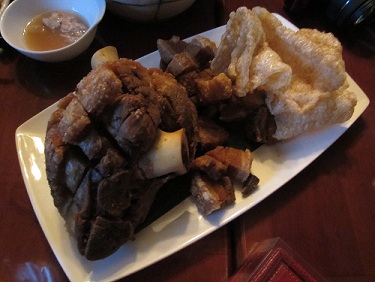Chef Tim Luym on Filipino Food
 Monday, November 5, 2012 at 4:00AM
Monday, November 5, 2012 at 4:00AM 
By Sandy Hu
The latest from Inside Special Fork
You might say the movie, Office Space, was ultimately responsible for the fabulous head-to-tail Filipino dinner Chef Tim Luym cooked at The Attic in San Mateo, California, recently.
The movie was an epiphany for Tim, then working in high-tech as an online marketer. “I felt just like the main guy – he had no sense of passion or any satisfaction at work,” Tim recalls. “And so all my friends said, ‘you should do something you really want to do.’”
Tim assessed his interests and skills. “I was into music. But I knew it wasn’t a viable, long-term career – no one wants to see a 50-year-old DJ.” So he pursued his other passion: cooking.
“I very naively quit my job and enrolled in cooking school,” Tim says. Upon graduation from the California Culinary Academy, he cooked for San Francisco chef Melissa Perello at the critically acclaimed Charles Nob Hill and then followed her to Fifth Floor, before he opened Poleng Lounge, abandoning upscale cooking for hip Asian street food. His talents won Tim acclaim: three stars in a San Francisco Chronicle restaurant review and recognition as a Chronicle Rising Star Chef and as a James Beard Rising Star Chef nominee. (Poleng Lounge closed in 2010, a victim of the economy.)
All the while, Tim was exploring his Filipino culinary roots. Of Spanish and Chinese descent, Tim was born in the Philippines and moved to the States when he was three years old. And while he could hold his own in the kitchens of high-end, white tablecloth restaurants, he wanted to express his own culinary heritage in a more approachable format.
 Sisig, cripsy pata, chicarrones, and pork belly
Sisig, cripsy pata, chicarrones, and pork belly“Fine dining is not a sustainable model,” he reflects. He points out that while these restaurants use the best products, there is a lot of waste – often the tastiest, but misunderstood bits. “There’s no way to sell the fish head, the bones, the non-perfect parts when diners are paying $150 to $200 for the tasting menu,” he says. “I used to take that stuff home – awesome fish heads, pig’s ears, pig’s tail – why not use all those parts that we were throwing away?”
It’s a matter of re-thinking your food prejudices, Tim says, pointing out that tuna was cat food until sushi became a mainstream hit, and now it’s premium fare – the most expensive fish in the world. As quality ingredients have gotten more expensive, more chefs are beginning to menu once-overlooked tendon, tripe, oxtails and other neglected parts.
Chef Tim, Today
Tim is trying to concentrate on doing a few things really well. He admires cooks who spend a lifetime trying to master one thing, like sushi chef Jiro, featured in the movie Jiro Dreams of Sushi. Or street food hawkers. Or cooks who do nothing but noodles and dumplings, their whole life.
Aside from consulting at The Attic, this talented chef is also in the food truck business with WOW Silog Truck and Frozen Kuhsterd. Wow truck serves a kind of Philippine breakfast food – you choose your protein, such as chicken, pork chop, fish or corned beef, and it’s served with garlic fried rice and fried egg. A Filipino version of a Denny’s Grand Slam breakfast, as Tim puts it, only with rice for hash browns and other meats instead of bacon or sausage. And, as with most breakfast foods, silog is great as a snack, lunch or dinner – comfort food for any time of the day.
Frozen Kuhsterd truck serves ice cream that Tim explains, has the best elements of crème brûlée, gelato and ice cream, all in one. It’s frozen like ice cream with the richness of gelato but because it’s a custard, never freezes hard. Made from natural and organic ingredients, flavors include avocado with condensed milk, toasted coconut, and other fun flavors.
 Fish head-to-tail sinigang
Fish head-to-tail sinigangWhen will Filipino Restaurants be Mainstream?
Filipino Americans are the second largest Asian immigrant group, behind Chinese Americans and ahead of Indians, Vietnamese, Korean and Japanese. But the number of Filipino restaurants doesn’t reflect the size of the population, and I was curious about Tim’s take on why not.
“There are several reasons,” he says. And his theory is evolving. “Now I think it needs a stronger sense of community support within the Filipino community here. We need Filipinos to be interested in having their food out there. Like Thai, Japanese or Chinese – the community needs to push for that to happen.
“Filipino Americans are highly adaptable to American society and culture because of the American influence in the Philippines. It’s not that they’re not proud to be Filipino or don’t have a sense of community. They just assimilate so much easier,” Tim surmises. This makes the need for food of their culture not as critical as for other immigrant groups.
The pragmatic chef also notes that it takes Filipino Americans to accept that if adobo or any other dish is made for the American palate it’s okay. “It doesn’t mean it’s not good.”
Recently Tim participated in an East Coast-West Coat collaboration of Filipino cooking in Brooklyn. “Filipino food is more popular there than here,” he explains. “Lots of New Yorkers are excited about it. They’re interested in the food and modern interpretations of the food – they try it and like it. Defining authentic Filipino food is not an issue. They just enjoy it as it is – there’s so much energy behind it. They enjoy it as food, rather than as traditional or strictly Filipino food.”
 "Death by pork"
"Death by pork"What is Filipino Food?
Tim went on to describe for me some characteristics of Filipino food, which include native food influences and influences from China and Spain. The Chinese did business all over Asia, including in the Philippines, and at one time, the Philippines was a Spanish colony, he explained.
Hot, tropical weather required food preparation techniques to prevent spoilage. Salting agents like soy sauce and salt helped to preserve meats and fish; marinating ingredients like vinegar served as another preserving and flavoring agent.
Tim describes his own cooking as “Modern Filipino food. I wouldn’t consider it Filipino fusion. I try to keep the integrity of the dish. Cooking techniques – methods learned working in different restaurants – provide the modern aspect. I try to present my dishes so they look palatable to people unfamiliar with Filipino food. I learned at the Fifth Floor that presentation key.”
Here’s one of the menu items Tim served at the head-to-tail dinner. While there may be some ingredients you haven’t cooked with before, the recipe is straightforward, quite do-able and delicious.
To get the recipe and shopping list on your smartphone (iPhone, BlackBerry, Android device) or PC, click here.
Bone Marrow Bulalo
Makes 1 serving
1 bone marrow
1 pound oxtails
1 onion, halved
2 tablespoons fish sauce
1 cup shredded cabbage
1/2 ear corn cut from the cob
1/2 saba plantain, cut into cubes, or regular plantain
2 tablespoons rice bran oil
1 fingerling potato (optional)
Sea salt
Soak bone marrow in salted water to draw out the impurities for 2 to 3 hours or overnight; this will make the marrow clear white and not mottled in color when cooked.
In a pot, cover oxtails with water to cover (about 2 cups); add onion and fish sauce. Bring to a boil, then simmer, covered, for 1 hour or until oxtails are tender and fall off the bone. Discard onion and reserve liquid.
Preheat oven to 350°F Roast bone marrow until cooked through, about 15 minutes.
Meanwhile, remove oxtails and shred meat off the bone; set aside. In the cooking liquid, cook cabbage, corn and plantain for 3 to 5 minutes until tender; remove vegetables and set aside.
Bring cooking liquid to a boil and reduce by half. You should have ¾ to 1 cup liquid. Return the cabbage, corn, and plantain to the pot; keep warm.
In a sauté pan, heat oil and add the pulled oxtail; sauté until crispy.
To plate, pour soup and vegetables into a shallow bowl, arranging vegetables in the middle to form a mound. Place roasted bone marrow on top of vegetables. Season with sea salt, to taste. Top with the crispy oxtail.
(To season, Tim uses X Roads Philippine Hand-Harvested Sea Salt.)
Special Fork is a recipe website for your smartphone and PC that solves the daily dinnertime dilemma: what to cook now! Our bloggers blog Monday through Friday to give you cooking inspiration. Check out our recipe database for quick ideas that take no more than 30 minutes of prep time. Follow us on Facebook , Twitter, Pinterest, and YouTube.
Related posts:
Reader Comments (1)
Wow! What are the nice sharing but I like the Bone Marrow Bulalo too much. It is my first time to look this recipe and like will be delicious to enjoy. Thanks
Culinary Entrepreneur